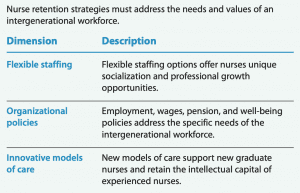22% of RNs May Leave Job This Year
 Takeaways:
Takeaways:
- 22% of RNs and 20% of nurse leaders may leave their position within the year as a result of their experiences during COVID-19.
- The increasing complexity of the healthcare system requires sophisticated strategies to address workforce retention.
- The pandemic uncovered new opportunities to explore flexible staffing options, address organizational policies, and experiment with new care models to leverage nursing expertise and retain new nurses.
On January 30, 2020, the World Health Organization declared the outbreak of COVID-19 a global public health concern due to its rapid spread and resulting high mortality. Nurses found themselves on the front lines of a healthcare crisis that changed their practices, organizations, communities, and the world. Two years later, nurses find themselves physically and mentally exhausted from the strain of battling the virus. With plummeting morale, nurses are leaving their jobs. Examining innovative strategies that emerged during the pandemic offers a glimmer of hope for addressing nurse retention beyond the pandemic.
Workforce shortages
In the wake of COVID-19, attitudes toward work are changing. Employees are leaving their jobs and looking for something better in what some economists call the Great Resignation. Nurses are no different. According to recent reports by McKinsey and Company and the American Organization of Nurse Leaders, 22% of RNs and 20% of nurse leaders may leave their positions within the year as a result of their experiences during the pandemic.
Also, an aging workforce and looming nursing shortage further complicate the retention crisis. The 2020 National Nursing Workforce Survey indicates that one-fifth of RNs will retire within 5 years, and the American Hospital Association’s 2021 Environmental Scan projects a shortage of 500,000 RNs by 2026. With a shrinking pool of experienced nurses, high nurse turnover rates, and an aging workforce, organizations must address the urgent need to retain nurses.
Retention strategies
No single solution exists to mitigate the retention crisis. Instead, a multifaceted approach to retention must address the unique needs of the nursing workforce. Innovative strategies that emerged during the pandemic include flexible staffing options and organizational policies, and creative models of care. (See Innovative retention strategies.)
Innovative Retention Strategies

Flexible staffing
Flexible staffing options include reciprocal employment agreements, flexible resource pools, clinical rotation opportunities, and tiered options for part-time and late-career nurses.
Reciprocal employment agreements. Because geography can be a factor in recruiting, hiring, and retaining RNs, hospitals are exploring reciprocal employment agreements. For example, during the pandemic, Intermountain Healthcare sent nurses to New York-Presbyterian and Northwell Health hospitals to support COVID-19 surges. Later, the New York hospitals sent nurses to the Colorado healthcare system to support seasonal surges.
Such reciprocal employment agreements meet the staffing needs of the organization and offer flexibility and travel opportunities to nurses. These opportunities may appeal to Millennial nurses (those born between 1980 and 1994) seeking to enhance their knowledge, experience, and expertise.
Flexible resource pools. Flexible resource pools provide a strategic and adaptable approach to meet unexpected demand and unique situations such as vaccine distribution. The 2021 Future of Nursing Work Survey, conducted by McKinsey and Company, found that, in 2020, nurses floated across units at twice the pre-pandemic rate.
Floating may not appeal to all nurses, but interest in this staffing option continues to grow. Larger healthcare systems might consider developing enterprise-wide pools that support not only a variety of units but also multiple hospitals and clinics.
Clinical rotation opportunities. Regular clinical rotation opportunities (perhaps monthly) for administrative nurses may offer them insight into the challenges faced by staff nurses. For example, nurse educators might learn more about preceptor challenges, and informatics nurses might uncover strategies for reducing electronic charting burdens.
Tiered options for part-time and late-career nurses. Tiered employment programs provide a structured series of steps for employees to reach their career goals. These programs particularly appeal to nurses who don’t want to work full-time and late-career or Baby Boomer nurses (those born between 1945 and 1964) nearing retirement.
Many nurses who left the workforce during the pandemic to care for children may be interested in returning with tiered employment options. For example, one South Carolina hospital aims to increase the percentage of part-time nursing staff to 30% to address the staffing needs of the organization and the personal needs of potential employees.
Organizational policies
By reshaping policies, organizations strive to ensure nurses feel valued, receive recognition, and have opportunities to grow.
Compensation. During the pandemic, organizations increased wages and offered bonuses or incentives to retain nurses. As the pandemic surged, compensation proved an effective way of moving nurses to parts of the country with increased staffing needs. Nurses willing to travel accepted temporary assignments farther from home with higher pay. Hospitals responded with bonuses and incentives to retain experienced nurses. Healthcare organizations continue to navigate the impact of COVID-19 and its effects on the nurse labor market. Generous compensation will continue to be a tool in that effort.
Stay interviews. Today more than ever, healthcare organizations need to understand why nurses leave. A stay interview can uncover deeper problems with management or the work environment, which if addressed, can influence a nurse’s decision to stay. It also provides an opportunity for managers to tailor retention efforts to an individual. For example, a nurse who expressed appreciation for serving on the committee evaluating a new product might receive an appointment to serve on a regular committee. Ideally, conduct stay interviews 2 or 3 months before an annual review, when nurses might reflect on their careers in anticipation of marking their anniversary dates.
Richard P. Finnegan, the author of The Power of Stay Interviews for Engagement and Retention, urges leaders to script these 15- to 20-minute interviews. He recommends asking these questions: What are you learning here? Why do you stay here? When was the last time you thought about leaving our team? What prompted it?
Paid time off. During the pandemic, work–life balance was anything but usual. Many nurses worked extra shifts while others experienced furloughs. Work-life balance is critical for emotional well-being, and a wellness culture supports time-off.
Organizations that mandate overtime should examine the long-term impact of such policies on retention. During staffing shortages, units may declare vacations on hold, or nurses may feel they can’t leave their colleagues in a time of need. Aligning paid time-off policies with organizational culture to ensure employees feel they have permission to take time off is an important strategy to improve physical and mental health. In addition, organizations should ask employees about their preferences for using time off, reduce barriers to scheduling it, create a campaign around taking time off, and set time-off goals for employees.
Well-being. Organizations are making nurse well-being a priority through strategies such as offering mental health services and providing healthy onsite meal options, and offering yoga, stress management, and e-coaching.
Innovative models of care
Organizations have developed new, innovative models of care to address emerging challenges resulting from the pandemic.
New graduate nurse transition. As new nurse graduates entered the workforce during the pandemic, transition to practice programs adapted to the unique needs of those whose education had been disrupted by COVID-19. In some instances, new graduate nurse orientation programs were accelerated and moved online.
The Organization of Nurse Leaders – MA, RI, NH, CT, VT, and the Massachusetts Rhode Island League for Nursing published recommendations to support new nurse transition into practice during the pandemic. These recommendations include establishing virtual support groups to allow new nurses to share concerns and ask questions; debriefing sessions for reflecting on and critiquing their experiences; and incorporating reflection and storytelling tools to aid experience processing. Mentoring serves as another effective strategy to support new nurses.




